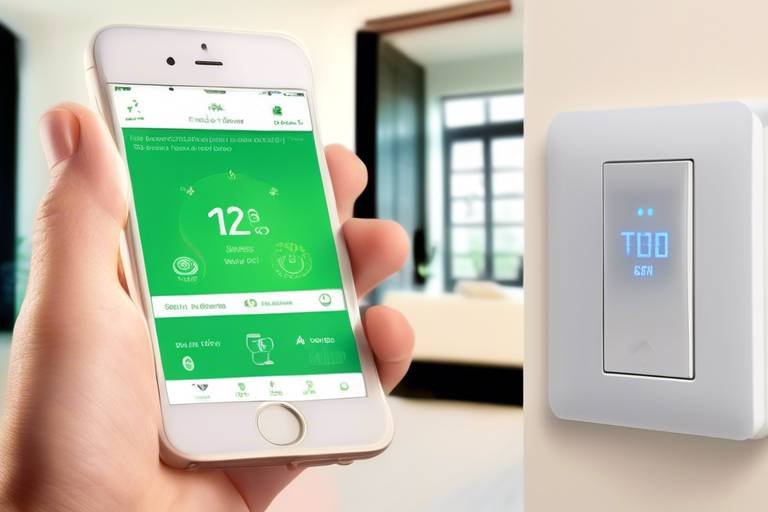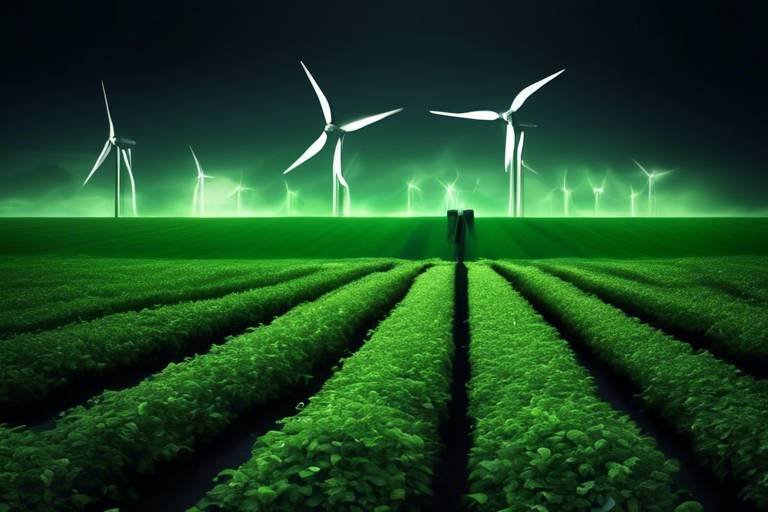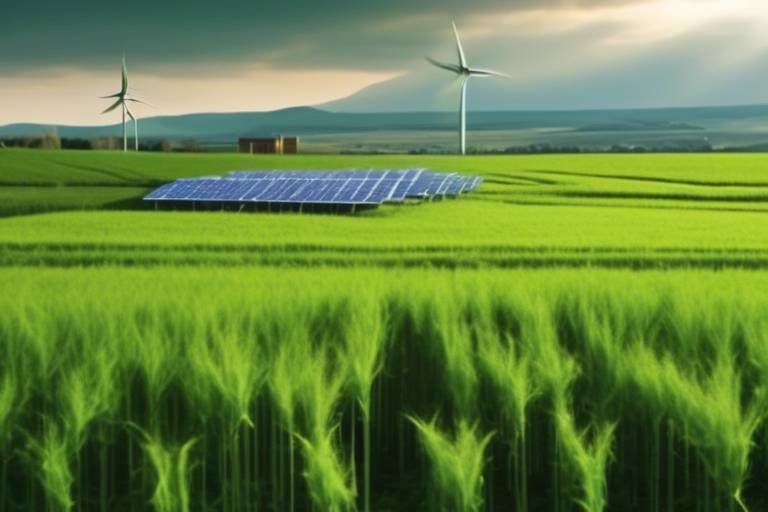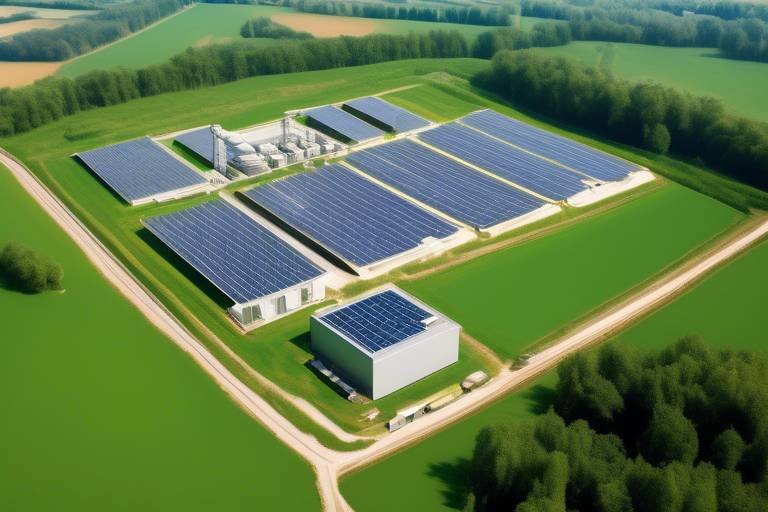Exploring The Effectiveness Of Green Energy Solutions
As the world grapples with the pressing challenges of climate change, the quest for sustainable energy solutions has never been more critical. Green energy solutions have emerged as a beacon of hope, offering not just a way to reduce our carbon footprint but also a pathway to a more sustainable future. But what exactly do we mean by “green energy”? In this article, we’ll dive deep into the various forms of green energy available today, their effectiveness in combating climate change, and the potential they hold for reshaping our energy landscape.
Green energy refers to renewable energy sources that are environmentally friendly and sustainable. These sources are not only abundant but also have a minimal impact on the planet compared to fossil fuels. The primary types of green energy include:
- Solar Energy: Harnessing the sun's power through solar panels, this form of energy is increasingly popular due to its accessibility and decreasing costs.
- Wind Energy: Utilizing wind turbines to generate electricity, wind energy is one of the fastest-growing sources of renewable energy worldwide.
- Hydropower: By capturing the energy of flowing water, hydropower remains one of the oldest forms of renewable energy, providing a significant portion of global electricity.
- Geothermal Energy: Tapping into the Earth's internal heat, geothermal energy offers a reliable source of power that is less dependent on weather conditions.
Each of these green energy sources comes with its unique set of benefits, including reduced greenhouse gas emissions, lower energy costs, and enhanced energy security. As we explore these solutions further, we’ll uncover how they contribute to a healthier planet and a sustainable economy.
Adopting green energy solutions presents a multitude of advantages that extend beyond environmental benefits. One of the most significant perks is the reduction in carbon emissions. By transitioning to renewable sources, we can drastically cut down on the pollutants that contribute to climate change. Furthermore, these solutions often lead to lower energy costs for consumers. Imagine slashing your utility bills while simultaneously helping the planet—sounds like a win-win, right?
Moreover, the shift towards green energy can improve public health by reducing air and water pollution. Cleaner energy sources mean cleaner air, which translates to fewer health issues related to pollution, such as respiratory diseases and heart conditions. This is particularly crucial for vulnerable populations who are disproportionately affected by environmental hazards.
Beyond environmental and health benefits, green energy solutions can significantly stimulate job creation and economic growth. The renewable energy sector is booming, creating a wide array of job opportunities that range from engineering and manufacturing to installation and maintenance. Investing in renewable energy technologies not only helps the planet but also boosts local economies.
According to recent studies, the renewable energy sector has seen an astonishing increase in job growth. The types of jobs created are diverse, including:
- Solar panel installers
- Wind turbine technicians
- Energy efficiency auditors
- Research and development roles in clean technology
Each of these positions requires a unique set of skills, and as the industry grows, so does the demand for training programs to equip workers with the necessary expertise.
One of the most appealing aspects of adopting green energy solutions is the potential for significant cost savings. By utilizing renewable energy sources, consumers can enjoy lower utility bills and reduced long-term energy expenses. For instance, solar energy systems can lead to substantial savings over time, often paying for themselves within a few years. This financial relief not only benefits individual households but also contributes to a more stable economy.
Green energy solutions play a vital role in reducing environmental degradation. By shifting away from fossil fuels, we can mitigate the harmful effects of climate change, contributing to cleaner air and water. These solutions also preserve biodiversity, helping to protect ecosystems that are essential for a balanced environment. In essence, embracing green energy is akin to giving Mother Nature a much-needed breath of fresh air.
Despite the myriad benefits, green energy solutions face several challenges that hinder their widespread adoption. Initial costs can be a significant barrier, as many renewable technologies require substantial upfront investments. Additionally, technological limitations and regulatory hurdles can impede progress. Understanding these challenges is crucial for developing effective strategies to overcome them.
Technological advancements are essential for the success of green energy. Current limitations in technology can restrict efficiency and accessibility. However, innovation is paving the way for breakthroughs that could revolutionize the industry. For example, improvements in battery storage technology are making it easier to harness solar and wind energy, even when the sun isn’t shining or the wind isn’t blowing.
Government policies significantly influence the adoption of green energy. Existing regulations can either facilitate or hinder the transition to renewable sources. Analyzing these policies and proposing changes that could streamline the process is vital for fostering a smoother transition to green energy.
Looking ahead, the future of green energy solutions appears promising. Emerging technologies are constantly reshaping the landscape, with innovations that could change how we consume energy. For instance, the development of smart grids is enhancing the efficiency of energy distribution, while energy storage solutions are addressing the intermittent nature of renewable sources.
New technologies are continually emerging in the green energy sector, promising to revolutionize energy consumption. Innovations such as advanced solar panels, offshore wind farms, and enhanced geothermal systems are just a few examples of how the industry is evolving. These technologies not only improve efficiency but also make renewable energy more accessible to a broader audience.
As we examine global trends in renewable energy adoption, it’s clear that some countries are leading the way. Nations like Germany, Denmark, and China are at the forefront of implementing green energy solutions, driven by policies that promote sustainability and innovation. Factors contributing to their success include government incentives, public awareness campaigns, and significant investments in research and development.
1. What are the main types of green energy? The primary types of green energy include solar, wind, hydro, and geothermal energy, each with its unique benefits and applications.
2. How does green energy impact the economy? Green energy solutions stimulate job creation and economic growth by providing new employment opportunities and reducing energy costs for consumers.
3. What challenges does green energy face? Key challenges include initial costs, technological limitations, and regulatory hurdles that can impede widespread adoption.
4. What is the future of green energy? The future of green energy looks bright, with emerging technologies and global trends indicating a significant shift toward renewable energy sources.

Understanding Green Energy
Green energy is not just a buzzword; it represents a crucial shift in how we harness power from our planet without damaging it. So what exactly is green energy? In simple terms, it refers to energy that is produced from renewable, zero-emissions sources that are naturally replenished. Think of it as a sustainable way to power our lives without leaving a hefty carbon footprint. The most popular forms of green energy include solar, wind, hydro, and geothermal energy. Each of these sources has unique characteristics, benefits, and applications that make them essential in the fight against climate change.
Let’s break it down a bit. Solar energy is harnessed from the sun's rays using solar panels. It's like capturing sunlight in a bottle and using it to power everything from homes to entire cities. Then we have wind energy, which is generated by wind turbines that convert the kinetic energy of wind into electricity. Imagine giant pinwheels spinning gracefully in the breeze, generating clean power as they turn. Hydro energy, on the other hand, relies on flowing water, typically from rivers or dams, to produce energy. It's like using the force of nature itself to create electricity. Lastly, geothermal energy taps into the Earth's internal heat, providing a stable and reliable energy source. Think of it as harnessing the warmth of the Earth’s core to heat your home or generate electricity.
Each of these green energy solutions comes with a plethora of benefits. For instance, they significantly reduce carbon emissions, which is a major contributor to global warming. By switching to renewable energy sources, we can lower our reliance on fossil fuels and help mitigate climate change. Moreover, the use of green energy can lead to lower energy costs in the long run. Although the initial investment might seem daunting, the savings on utility bills can be substantial over time. In addition, adopting green energy solutions can lead to improved public health. By reducing air pollution, we can decrease respiratory and cardiovascular diseases, ultimately leading to a healthier society.
In summary, understanding green energy is about recognizing its potential to transform our energy landscape. By embracing these renewable sources, we can pave the way for a sustainable future. As we continue to explore these solutions, we must also consider how we can overcome the challenges associated with their adoption, ensuring that we can leverage their benefits for generations to come.

Benefits of Green Energy Solutions
When we think about the future of our planet, the **benefits of green energy solutions** shine brighter than a summer sun. Transitioning to renewable energy sources such as solar, wind, and hydroelectric power not only helps in reducing our carbon footprint but also offers a plethora of advantages that can enhance our quality of life. Imagine a world where energy is abundant, clean, and affordable. Sounds dreamy, right? Well, that dream is becoming a reality, and here's why.
First off, let's talk about **reduced carbon emissions**. Traditional energy sources like coal and natural gas release harmful greenhouse gases into the atmosphere, contributing to climate change. In contrast, green energy solutions produce little to no emissions during operation. For example, solar panels harness sunlight, while wind turbines convert wind energy into electricity without polluting our air. By adopting these renewable sources, we can significantly lower our environmental impact and help mitigate the effects of global warming.
Another major benefit is the potential for **lower energy costs**. Yes, you heard that right! While the initial investment in renewable energy technologies might seem daunting, the long-term savings can be substantial. For instance, homeowners who install solar panels can drastically reduce their electricity bills, and in some cases, even eliminate them altogether! Over time, these savings can add up, making green energy not just an eco-friendly choice but also a financially smart one.
Moreover, embracing green energy solutions can lead to **improved public health**. The pollutants released from fossil fuel combustion are linked to respiratory diseases, heart conditions, and other health issues. By transitioning to cleaner energy sources, we can enjoy cleaner air and a healthier population. A recent study indicated that cities that invest in renewable energy see a notable decline in health-related issues, which in turn reduces healthcare costs for individuals and governments alike.
Let's not forget the **economic impact** of green energy solutions. Investing in renewable energy technologies can stimulate job creation and economic growth. The renewable energy sector is booming, with opportunities ranging from engineering and manufacturing to installation and maintenance. According to recent statistics, the renewable energy industry has created millions of jobs worldwide, providing a sustainable employment landscape that benefits local economies. As more people transition to green energy, we can expect this trend to continue, fostering a robust job market.
In summary, the benefits of green energy solutions are vast and multifaceted. From reducing carbon emissions and lowering energy costs to improving public health and stimulating economic growth, the advantages are compelling. As we continue to explore and invest in these renewable sources, we are not just making a choice for today; we are paving the way for a sustainable future for generations to come.
- What are the main types of green energy? The main types include solar, wind, hydroelectric, geothermal, and biomass energy.
- How does green energy reduce carbon emissions? Green energy sources produce little to no greenhouse gases during operation, which helps combat climate change.
- Can green energy save me money? Yes! While the initial setup may be costly, the long-term savings on energy bills can be significant.
- What jobs are available in the green energy sector? Jobs range from engineering and manufacturing to installation and maintenance of renewable energy technologies.
- How does green energy impact public health? By reducing air pollutants, green energy contributes to cleaner air and can lower the incidence of respiratory and heart diseases.

Economic Impact
The transition to green energy solutions is not just a win for the environment; it also offers substantial economic benefits that can transform communities and nations. Imagine a world where clean energy not only powers our homes but also fuels economic growth. This is not just a dream; it’s becoming a reality as investments in renewable energy technologies are on the rise. By shifting our focus to sustainable energy sources, we can stimulate job creation and foster economic growth in a way that traditional energy sectors simply cannot match.
As the demand for renewable energy increases, so do the opportunities for local economies. When communities invest in green energy, they are investing in their future. The renewable energy sector has already created millions of jobs worldwide, and this trend is expected to continue. These jobs range from manufacturing solar panels to installing wind turbines, and they require a variety of skills. For instance, technicians, engineers, and project managers are just a few examples of the diverse roles that are emerging in this field.
Furthermore, the economic impact of green energy extends beyond job creation. Consumers can experience significant cost savings as renewable energy sources typically lead to lower utility bills. For example, households that utilize solar energy can drastically reduce their electricity costs, sometimes even eliminating them entirely. This not only helps families save money but also allows them to redirect those funds into other areas of the economy, further stimulating growth.
To illustrate the economic benefits of green energy, let’s take a look at the following table that summarizes the key advantages:
| Economic Benefit | Description |
|---|---|
| Job Creation | Renewable energy sectors are rapidly increasing employment opportunities across various skill levels. |
| Cost Savings | Consumers can save significantly on energy bills by adopting renewable energy solutions. |
| Local Investment | Investments in green technologies boost local economies and foster sustainable development. |
Moreover, the green energy sector can stimulate innovation and technological advancements, leading to new business opportunities. As companies strive to develop more efficient energy solutions, they often create spin-off industries that can lead to further job creation and economic diversification. This ripple effect can help communities transition from traditional energy sources, which are often subject to market volatility, to more stable and predictable renewable options.
In conclusion, the economic impact of green energy solutions is profound and multifaceted. By embracing renewable energy, we are not only taking significant strides towards environmental sustainability but also paving the way for a robust and resilient economy. The future is bright for green energy, and with it comes the promise of a thriving economy that benefits everyone.
- What are the main types of green energy? Green energy primarily includes solar, wind, hydroelectric, and geothermal energy.
- How does green energy create jobs? The renewable energy sector creates jobs in manufacturing, installation, maintenance, and research and development.
- Can green energy save me money? Yes, many renewable energy solutions can lead to significant savings on utility bills over time.
- What are the environmental benefits of green energy? Green energy helps reduce carbon emissions, improve air and water quality, and preserve biodiversity.

Job Creation in Renewable Sectors
The renewable energy sector is not just a buzzword; it's a booming industry that is transforming the job market. As the world shifts towards sustainable energy solutions, the demand for skilled labor in this field is skyrocketing. This transition is creating a myriad of job opportunities that range from technical roles to administrative positions. In fact, the International Renewable Energy Agency (IRENA) reported that the renewable energy sector employed over 11 million people globally in 2018, and that number has only continued to rise. So, what types of jobs are we talking about? Let's break it down.
At the forefront, we have engineering roles, which are crucial for designing and implementing renewable energy systems. Engineers specializing in solar, wind, and geothermal technologies are in high demand. Then, there are technicians who maintain and repair these systems, ensuring they operate efficiently. Moreover, the sector also needs project managers who oversee the development of renewable energy projects, making sure they are completed on time and within budget.
But it doesn't stop there! The renewable energy industry also requires a range of support roles, such as sales and marketing professionals who help promote these green technologies, and research and development teams that focus on innovating and improving existing technologies. The variety of positions available means that there are opportunities for individuals with different skill sets and educational backgrounds. Whether you're a seasoned engineer or a recent graduate looking to make a difference, there’s a place for you in this thriving sector.
To give you a clearer picture, here’s a quick overview of the types of jobs and the skills required in the renewable energy sector:
| Job Type | Skills Required |
|---|---|
| Renewable Energy Engineer | Engineering degree, problem-solving skills, understanding of energy systems |
| Solar Panel Technician | Technical training, electrical knowledge, troubleshooting skills |
| Project Manager | Leadership skills, organizational skills, knowledge of project management software |
| Sales and Marketing Specialist | Communication skills, marketing knowledge, understanding of renewable technologies |
| Research Scientist | Advanced degree in relevant field, analytical skills, experience with data analysis |
As we can see, the renewable energy sector is not only creating jobs but also fostering a workforce that is equipped to meet the challenges of the future. The skills required are diverse, which means that as the industry grows, it can accommodate a wide range of talents. With ongoing investments and innovations, the potential for job creation in renewable energy is immense. This growth not only benefits individuals seeking employment but also contributes to the economic stability of communities, making the transition to sustainable energy a win-win situation for everyone involved.
- What types of jobs are available in the renewable energy sector?
There are various roles including engineers, technicians, project managers, sales and marketing professionals, and research scientists.
- Do I need a specific degree to work in renewable energy?
While many positions require degrees in engineering or environmental science, there are also roles that prioritize technical training and experience.
- How does working in renewable energy impact the environment?
Working in this sector contributes to reducing carbon emissions and promotes sustainability, making a positive impact on the environment.

Cost Savings for Consumers
Adopting green energy solutions isn't just a win for the planet; it's also a fantastic way for consumers to save money. Imagine waking up to a utility bill that’s significantly lower than what you’re used to. Sounds like a dream, right? Well, with renewable energy sources like solar and wind, this dream can become a reality. The initial investment may seem daunting, but the long-term savings are where the magic happens.
First off, let's talk about solar energy. When you install solar panels on your roof, you're not just generating your own electricity; you're also reducing your dependency on the grid. This can lead to substantial savings over time. In fact, many homeowners report saving anywhere from 20% to 50% on their electricity bills once they switch to solar energy. And don't forget about those government incentives and tax credits that can help offset the installation costs. It's like getting paid to go green!
Then there’s wind energy. While not every home is equipped for wind turbines, those that are can also enjoy significant savings. According to a study, households that utilize wind energy can save an average of $400 annually. This is especially beneficial in areas with high wind potential. The beauty of renewable energy is that it often leads to lower operational costs over time, as the fuel (like sunlight or wind) is free!
Now, let’s not overlook the environmental benefits that come with these savings. By reducing carbon emissions and relying less on fossil fuels, you're not just saving money; you're also contributing to a healthier planet. Cleaner air and water can lead to better public health, which ultimately saves everyone money in healthcare costs. It’s a win-win situation!
To give you a clearer picture of the cost savings associated with different green energy solutions, here's a quick comparison table:
| Energy Source | Average Annual Savings | Initial Investment |
|---|---|---|
| Solar Energy | $1,000 - $2,500 | $15,000 - $30,000 |
| Wind Energy | $400 | $30,000 - $50,000 |
| Geothermal Energy | $500 - $1,500 | $10,000 - $25,000 |
As you can see, while the initial investments can be substantial, the long-term savings often make these options worthwhile. Plus, many states and local governments offer incentives to help offset these costs, making it even easier to make the switch. So, if you're still on the fence about going green, consider the financial benefits that come with it. Your wallet and the environment will thank you!
- What are the most common types of green energy? The most common types include solar, wind, hydro, and geothermal energy.
- How much can I save by switching to renewable energy? Savings can vary, but many homeowners report saving between 20% to 50% on their energy bills.
- Are there government incentives for adopting green energy? Yes, many governments offer tax credits and rebates to help offset the costs of renewable energy installations.
- Is renewable energy reliable? Yes, with advancements in technology, renewable energy sources are becoming increasingly reliable and efficient.

Environmental Benefits
Green energy solutions are not just a trend; they are essential for the survival of our planet. By harnessing renewable energy sources like solar, wind, hydro, and geothermal, we can significantly reduce our carbon footprint. This transition from fossil fuels to green energy is crucial for combating climate change, which is one of the most pressing issues of our time. Imagine a world where the air is clean, the water is pure, and the ecosystems are thriving—this is the promise of green energy.
One of the most significant environmental benefits of green energy is the reduction of greenhouse gas emissions. Traditional energy sources, such as coal and natural gas, release vast amounts of carbon dioxide and other harmful pollutants into the atmosphere. In contrast, renewable energy sources produce little to no emissions. For instance, according to recent studies, switching to solar power can reduce a household's carbon emissions by up to 80%. This reduction is not just beneficial for our health; it also contributes to the preservation of wildlife and natural habitats.
Additionally, the use of green energy leads to improved air and water quality. Fossil fuel extraction and burning result in toxic byproducts that contaminate our air and waterways. By adopting renewable energy solutions, we can mitigate these harmful effects. For example, wind energy not only generates electricity without emissions but also requires less water than traditional power generation methods. This is crucial in areas facing water scarcity, where conserving water resources is a top priority.
Moreover, green energy technologies often promote biodiversity. By reducing habitat destruction and pollution, we create a healthier environment for various species to thrive. For instance, solar farms can be designed to coexist with agriculture, allowing for dual land use that benefits both energy production and food supply. This symbiotic relationship exemplifies how renewable energy can foster a more sustainable ecosystem.
To illustrate the positive environmental impacts of green energy, consider the following table that highlights the differences between traditional and renewable energy sources:
| Energy Source | Greenhouse Gas Emissions | Water Usage | Impact on Biodiversity |
|---|---|---|---|
| Coal | High | High | Negative |
| Natural Gas | Moderate | Moderate | Negative |
| Solar | Low | Very Low | Positive |
| Wind | Very Low | Very Low | Positive |
| Hydro | Low | Moderate | Mixed |
In conclusion, the environmental benefits of green energy solutions are profound and far-reaching. They not only help in reducing harmful emissions and conserving water but also play a vital role in preserving our planet's biodiversity. As we continue to innovate and invest in these technologies, we move closer to a cleaner, healthier, and more sustainable future for generations to come.
- What is green energy? Green energy refers to renewable energy sources that are environmentally friendly and sustainable, such as solar, wind, hydro, and geothermal.
- How does green energy reduce carbon emissions? Green energy sources produce little to no greenhouse gases during their operation, significantly lowering the overall carbon footprint compared to fossil fuels.
- What are the economic benefits of green energy? Green energy solutions can stimulate job creation and lead to lower energy costs for consumers, contributing to economic growth.
- Are there any challenges in adopting green energy? Yes, challenges include initial costs, technological limitations, and regulatory hurdles that can hinder widespread adoption.

Challenges Facing Green Energy Adoption
While the transition to green energy solutions is undeniably crucial for a sustainable future, it doesn't come without its fair share of challenges. One of the most significant hurdles is the initial cost associated with installing renewable energy systems. For many businesses and homeowners, the upfront investment in solar panels, wind turbines, or geothermal systems can be daunting. Although these technologies often lead to substantial savings over time, the initial financial burden can deter potential adopters. Think of it like buying a high-efficiency washing machine; while it saves money on water and energy bills in the long run, the sticker shock at the store can be a real barrier.
Another challenge lies in technological limitations. Despite the rapid advancements in renewable energy technologies, there are still issues related to efficiency and reliability that need to be addressed. For instance, solar panels are dependent on sunlight, which means their effectiveness can vary dramatically based on geographic location and weather conditions. This variability can lead to uncertainty in energy production, making it less appealing for businesses that rely on consistent energy supply. Moreover, the current energy storage solutions, while improving, still lag behind in providing a robust backup for renewable sources, leading to potential energy shortages during peak demand times.
Regulatory hurdles also play a significant role in hindering the widespread adoption of green energy. Many regions have outdated policies that favor traditional fossil fuels over renewable sources. These regulations can create a complex landscape for businesses looking to invest in green technologies. For example, in some areas, interconnection fees for renewable energy systems can be prohibitively high, discouraging homeowners from making the switch. Furthermore, a lack of incentives or subsidies for renewable energy projects can leave potential investors feeling unsupported. This is where government action is crucial; without favorable policies, the transition to green energy can feel like trying to run a marathon in heavy boots.
Lastly, public perception poses another challenge. Many people are still unaware of the benefits of green energy or may harbor misconceptions about its reliability and efficiency. Education and outreach programs are essential to inform the public about the long-term advantages of switching to renewable sources. Just as we’ve seen a shift in attitudes toward recycling and sustainable practices, a similar transformation is needed for green energy adoption. By fostering a culture that values sustainability, we can encourage more individuals and businesses to embrace these solutions.
In summary, while the road to green energy adoption is fraught with challenges, each obstacle presents an opportunity for innovation and growth. By addressing financial, technological, regulatory, and perceptual barriers, we can pave the way for a cleaner, more sustainable energy future.
- What are the main challenges in adopting green energy?
The main challenges include high initial costs, technological limitations, regulatory hurdles, and public perception issues. - How can technology improve green energy adoption?
Technological advancements can enhance efficiency, reliability, and energy storage solutions, making renewable energy more appealing. - What role do government policies play in green energy adoption?
Government policies can either facilitate or hinder the transition to renewable energy through regulations, incentives, and subsidies. - How can public perception be changed regarding green energy?
Education and outreach programs can help inform the public about the benefits of green energy, leading to increased adoption.

Technological Barriers
When we talk about green energy solutions, it's impossible to ignore the significant that often stand in the way of their widespread adoption. While the potential of renewable energy sources like solar, wind, and hydro is immense, the technology we currently have isn't always up to par. Think of it like trying to run a marathon in shoes that are two sizes too small; you might have the willpower to keep going, but you're going to face some serious challenges along the way.
One of the primary issues is the efficiency of energy conversion. Many renewable technologies still struggle to convert natural energy into usable power effectively. For instance, traditional solar panels convert only about 15-20% of sunlight into electricity. While this number is gradually improving with advancements in technology, we still have a long way to go before we can maximize solar energy's potential. Imagine if we could harness 100% of the sunlight that hits our panels; the implications would be staggering!
Moreover, the intermittency of renewable energy sources poses another challenge. The sun doesn't always shine, and the wind doesn't always blow, which means energy production can be inconsistent. This variability complicates the task of maintaining a stable energy supply, leading to a reliance on traditional fossil fuels as backup sources. To mitigate this issue, we need advancements in energy storage technologies that can hold energy produced during peak times for use when production dips. Currently, battery technologies are improving, but they're not yet at the level where they can fully support a grid powered by renewables alone.
In addition to these challenges, there are also infrastructure limitations. Our current energy grid was designed with fossil fuels in mind, and while it can accommodate some renewable sources, it isn't optimized for them. Upgrading this infrastructure to support a higher percentage of renewable energy will require significant investment and innovation. It’s like trying to fit a square peg into a round hole; without the right adjustments, things just won’t work smoothly.
Lastly, we can't overlook the issue of public acceptance and understanding. Many people remain skeptical about the reliability and effectiveness of green technologies, often due to misinformation or a lack of knowledge. Education and outreach are essential to overcoming this barrier. If we can help people understand the benefits and realities of green energy, we can foster a more supportive environment for technological advancements.
In summary, while the path to a greener energy future is fraught with , the potential rewards are worth the effort. By investing in research and development, we can address these challenges and pave the way for a more sustainable energy landscape.
- What are the main technological barriers to green energy adoption?
The main barriers include energy conversion efficiency, intermittency of renewable sources, infrastructure limitations, and public acceptance.
- How can we improve the efficiency of renewable energy technologies?
Investing in research and development, as well as adopting new materials and designs, can significantly enhance efficiency.
- What role does energy storage play in renewable energy?
Energy storage allows us to store excess energy produced during peak times for use when production is low, helping to stabilize the energy supply.

Policy and Regulation Issues
When it comes to the adoption of green energy solutions, government policies and regulations play a pivotal role. These frameworks can either act as a catalyst for innovation and growth or serve as a barrier to progress. One of the significant challenges is the inconsistency in regulations across different regions. For instance, while some countries have embraced ambitious renewable energy targets, others lag behind due to outdated policies or a lack of incentives. This inconsistency can create confusion for investors and companies looking to enter the green energy market.
Moreover, the initial costs associated with transitioning to renewable energy can be daunting. Many governments provide subsidies for fossil fuels, which can skew the market and make it difficult for green energy solutions to compete on a level playing field. Without adequate support, renewable energy projects often struggle to secure funding, leading to a slower adoption rate. It’s like trying to race a bicycle against a car; without the right support, the bicycle is at a significant disadvantage.
In addition to financial barriers, regulatory hurdles can also stifle innovation. For instance, lengthy permitting processes can delay the deployment of renewable energy projects. This not only affects the timeline for getting projects off the ground but also increases costs, which can ultimately be passed on to consumers. A streamlined regulatory process is essential for fostering a more favorable environment for green energy initiatives.
To address these challenges, many experts advocate for comprehensive policy reforms that prioritize renewable energy. Such reforms could include:
- Implementing tax incentives for both consumers and businesses that invest in renewable energy technologies.
- Establishing clear and consistent regulations that facilitate the growth of green energy projects.
- Encouraging public-private partnerships to leverage resources and expertise in the transition to sustainable energy.
By creating a supportive regulatory framework, governments can not only accelerate the adoption of green energy solutions but also stimulate economic growth and job creation in the process. The transition to renewable energy is not just about environmental benefits; it's also about creating a sustainable future for economies and communities worldwide.
Q1: What are some common barriers to adopting green energy solutions?
A1: Common barriers include high initial costs, inconsistent regulations, and lengthy permitting processes that can delay project deployment.
Q2: How can government policies promote green energy?
A2: Governments can promote green energy by offering tax incentives, creating consistent regulations, and supporting public-private partnerships.
Q3: What role does technology play in overcoming regulatory issues?
A3: Technological advancements can improve efficiency and reduce costs, making it easier for renewable energy solutions to compete with traditional energy sources.

Future of Green Energy Solutions
The future of green energy solutions is not just a distant dream; it is rapidly becoming our reality. As we stand at the crossroads of technological advancement and environmental necessity, the potential for renewable energy to reshape our world is immense. Imagine a future where our homes, cars, and industries run on clean, sustainable energy sources. This is not merely a fantasy; it is a tangible goal that many countries are actively pursuing. With innovations in technology and a growing awareness of climate issues, the green energy sector is poised for explosive growth.
One of the most exciting aspects of this future is the emergence of new technologies that promise to revolutionize how we consume energy. For instance, energy storage solutions are becoming more sophisticated, allowing us to harness renewable energy even when the sun isn't shining or the wind isn't blowing. These advancements ensure a stable energy supply, making renewables more reliable than ever. Additionally, the development of smart grids is transforming the energy landscape. Smart grids utilize digital technology to manage electricity demand efficiently, reducing waste and optimizing energy use. This means that when you turn on a light switch, you can be confident that the energy powering it is as clean as possible.
Furthermore, global trends indicate a significant shift towards renewable energy adoption. Countries like Germany and China are leading the charge, investing heavily in solar and wind energy. Their success can be attributed to a combination of government support, technological innovation, and public awareness. For example, Germany's feed-in tariff system has incentivized homeowners and businesses to invest in solar panels, resulting in a substantial increase in renewable energy production. As these trends continue, we can expect to see a domino effect, with more nations following suit and committing to greener energy solutions.
However, it’s essential to recognize that the path to a greener future is not without its challenges. While the potential is vast, we must navigate obstacles such as regulatory hurdles and the need for substantial investment in infrastructure. Governments and private sectors must collaborate to create policies that foster innovation and support the transition to renewable energy. This collaboration will not only enhance energy security but also stimulate economic growth and job creation in the green sector.
In conclusion, the future of green energy solutions is bright and full of promise. With emerging technologies paving the way for cleaner, more efficient energy consumption, we are on the brink of a significant transformation. As we embrace these changes, we must remain vigilant about the challenges that lie ahead. By working together, we can ensure that green energy becomes the cornerstone of a sustainable and prosperous future for all.
- What are the main types of green energy? Green energy primarily includes solar, wind, hydroelectric, and geothermal energy sources.
- How does green energy impact the economy? Green energy solutions can stimulate job creation, lower energy costs, and promote economic growth through investments in renewable technologies.
- What challenges does green energy face? The main challenges include high initial costs, technological barriers, and regulatory hurdles that can impede widespread adoption.
- What is the role of technology in green energy? Technology plays a critical role in improving the efficiency of renewable energy systems and making them more accessible to consumers.
- How can individuals contribute to green energy adoption? Individuals can contribute by supporting renewable energy initiatives, investing in solar panels, and advocating for policies that promote sustainability.

Emerging Technologies
As we venture deeper into the 21st century, the landscape of green energy is rapidly evolving, driven by a wave of that promise to transform how we generate, store, and consume energy. Imagine a world where energy is not only clean but also efficient and accessible to everyone. This vision is becoming a reality thanks to innovations in various fields. One of the most exciting developments is in energy storage solutions. Traditionally, renewable energy sources like solar and wind have been criticized for their intermittency; they generate energy only when the sun shines or the wind blows. However, advancements in battery technology, particularly lithium-ion and emerging solid-state batteries, are paving the way for more reliable energy supply. These batteries can store excess energy produced during peak production times and release it when demand surges, ensuring a stable energy flow.
Another groundbreaking innovation is the development of smart grids. These digital systems enable two-way communication between energy providers and consumers, allowing for real-time monitoring and management of energy usage. With smart grids, households can optimize their energy consumption, reducing waste and lowering costs. They can even integrate with home automation systems to manage energy use based on availability and pricing. For instance, during times of low demand, smart appliances can run, ensuring that energy is used efficiently. This technology not only enhances energy efficiency but also supports the integration of more renewable sources into the grid, making it more resilient and sustainable.
Moreover, the rise of microgrids is another promising trend in the realm of green energy. These localized energy systems can operate independently or in conjunction with the main grid. Microgrids can utilize a mix of renewable energy sources, such as solar panels and wind turbines, along with energy storage systems. This flexibility allows communities to achieve energy independence and resilience, especially in remote areas or regions prone to natural disasters. The ability to generate and manage energy locally means reduced transmission losses and a smaller carbon footprint.
In addition to these technologies, innovations in hydrogen fuel cells are gaining traction. Hydrogen, when produced through renewable methods, can serve as a clean fuel source for vehicles and power generation. Fuel cells convert hydrogen into electricity, emitting only water vapor as a byproduct. This technology holds immense potential for decarbonizing sectors that are hard to electrify, such as heavy transportation and industrial processes. Countries like Japan and Germany are leading the charge in hydrogen technology, investing heavily in infrastructure and research to make hydrogen a viable alternative to fossil fuels.
Finally, let's not overlook the role of artificial intelligence (AI) in optimizing energy systems. AI can analyze vast amounts of data to predict energy demand, optimize energy consumption, and enhance the efficiency of renewable energy systems. For instance, AI algorithms can predict weather patterns to optimize solar panel output or manage battery storage more effectively. By harnessing the power of AI, we can create smarter, more responsive energy systems that adapt to our needs in real time.
In conclusion, the future of green energy is bright, thanks to these . As we continue to innovate and invest in these solutions, we can expect a significant shift in how we think about and use energy. The transition to a sustainable energy future is not just a possibility; it is becoming an exciting reality.
- What are the main benefits of emerging green energy technologies? Emerging technologies enhance energy efficiency, reduce reliance on fossil fuels, and lower greenhouse gas emissions.
- How do smart grids work? Smart grids use digital technology to monitor and manage energy flow, allowing for real-time adjustments and better integration of renewable sources.
- What role does AI play in green energy? AI helps optimize energy consumption, predict demand, and improve the efficiency of renewable energy systems.
- Are hydrogen fuel cells a practical solution for energy needs? Yes, hydrogen fuel cells offer a clean alternative for sectors that are difficult to electrify, with water vapor as the only emission.

Global Trends in Renewable Energy
The landscape of renewable energy is evolving at an astonishing pace, with countries around the world embracing green solutions in ways we’ve never seen before. As we look at the , it's clear that this shift isn’t just a fleeting moment; it’s a fundamental change in how we think about energy production and consumption. For instance, nations like Germany and China are leading the charge, demonstrating that investing in renewable technologies can yield substantial economic and environmental benefits.
Germany’s Energiewende policy is a prime example of ambitious renewable energy goals. This initiative aims to transition the country away from fossil fuels and nuclear energy towards sustainable sources, with a target of achieving 80% of its energy from renewables by 2050. The results have been remarkable, showcasing how a concerted effort can lead to a significant reduction in carbon emissions while also creating thousands of jobs in the renewable sector.
Meanwhile, China has emerged as a powerhouse in the renewable energy market, not just in production but also in innovation. The country is the world’s largest producer of solar panels and has invested heavily in wind power. In fact, according to recent statistics, China accounts for over 30% of global renewable energy investment. This trend is not only about energy generation; it’s about energy independence and security, which many nations are beginning to recognize as critical to their future.
Another trend is the increasing adoption of smart grid technologies. These innovations allow for better management of energy supply and demand, making it easier to integrate renewable sources into the existing energy infrastructure. Countries like the United States and India are investing in smart grid solutions that facilitate the use of solar and wind energy, thereby reducing reliance on traditional energy sources. Smart grids can optimize energy distribution, improve reliability, and enhance the overall efficiency of energy consumption.
Moreover, the global push for electric vehicles (EVs) is closely tied to renewable energy trends. As more consumers shift towards EVs, the demand for clean energy sources to power these vehicles is skyrocketing. Governments are recognizing this shift and are implementing policies that encourage the use of green energy in transportation. For instance, in Norway, electric vehicles accounted for over 54% of all new car sales in 2020, largely supported by incentives and a robust charging infrastructure powered by renewable energy.
However, it's essential to acknowledge that these trends come with challenges. While the momentum is promising, issues such as intermittency of renewable sources and the need for energy storage solutions must be addressed. Countries are actively researching and developing technologies that can store energy generated from renewables, ensuring a stable supply even when the sun isn’t shining or the wind isn’t blowing.
In summary, the global trends in renewable energy showcase a dynamic shift towards sustainable practices. With countries leading the way in innovative policies and technologies, the future of energy looks increasingly green. The commitment to reducing carbon footprints and promoting sustainable development is not just a trend; it’s a necessary evolution for our planet's health and future generations. As we continue to observe these trends, it's crucial to stay informed and engaged in the conversation about renewable energy solutions.
- What are the main types of renewable energy? The primary types include solar, wind, hydroelectric, geothermal, and biomass.
- How does renewable energy benefit the environment? It reduces greenhouse gas emissions, decreases air pollution, and conserves natural resources.
- Are renewable energy sources reliable? While they can be intermittent, advancements in technology, such as energy storage, are improving their reliability.
- What can individuals do to support renewable energy? Individuals can invest in solar panels, support green energy policies, and reduce energy consumption.
Frequently Asked Questions
- What is green energy?
Green energy refers to energy derived from renewable sources that have a minimal impact on the environment. This includes sources like solar, wind, hydro, and geothermal energy, all of which help reduce our carbon footprint and combat climate change.
- How does green energy benefit the environment?
Green energy significantly reduces carbon emissions, leading to cleaner air and water. By shifting away from fossil fuels, we can preserve biodiversity and mitigate the effects of climate change, creating a healthier planet for future generations.
- Can green energy solutions save me money?
Absolutely! By adopting green energy solutions, many consumers experience lower utility bills and reduced long-term energy expenses. Investing in renewable energy can lead to significant savings over time, especially with technologies like solar panels.
- What are the job prospects in the green energy sector?
The renewable energy sector is booming, creating numerous job opportunities in various fields. From engineers to technicians and project managers, there are many roles available that require different skill sets, contributing to sustainable economic growth.
- What challenges does green energy face?
Despite its benefits, green energy adoption faces challenges such as high initial costs, technological limitations, and regulatory hurdles. Addressing these issues is essential for facilitating a broader transition to renewable energy sources.
- What emerging technologies are shaping the future of green energy?
Innovations like energy storage solutions and smart grids are at the forefront of green energy advancements. These technologies have the potential to revolutionize how we consume energy, making it more efficient and accessible for everyone.
- Which countries are leading in renewable energy adoption?
Countries like Germany, China, and the United States are at the forefront of renewable energy implementation. Their success is driven by supportive policies, technological advancements, and public awareness of the importance of sustainable energy solutions.



















